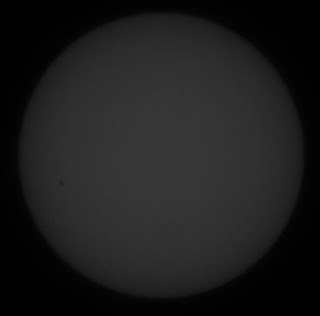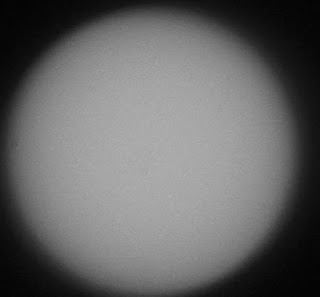October 31st 1115 GMT Sun and
Moon
The waning crescent moon was getting more
slender and nearer to the Sun. I snapped it with my DSLR at 300mm focal length,
ISO 100 and 1/200 second exposure.
I then added my full-aperture Baader
solar filter to the set-up and reduced the exposure time to 1/2000 second
exposure.
October 30th 0930 GMT Sun and Moon
There were some clear spells and I managed to do a quick photo shoot before cloud rolled in again. I snapped the Sun with my DSLR at 300mm focal length, ISO 100 and 1/1000 second exposure. I caught a faint imprint of some small sunspots.
The Moon shot was more successful, capturing the waning crescent phase and its craters. I used my DSLR at b300mm focal length, ISO 400 and 1/200 second exposure.
October 26th Cassiopeia Reprocessed
With wall-to-wall cloud, I revisited some photos from August 1st 2020. I used the Exposure function in GIMP and adjusted the brightness and contrast.
October
25th 0450 GMT Betelguese and Moon
It
was cloudy when I got up but cleared after Breakfast. I checked Betelguese and
confirmed its magnitude of 0.5. This confirmed that it had faded quite rapidly
but seemed to have stabilised.
I
also snapped the waning gibbous moon at 300mm focal length, ISO 100 and 1/200
second exposure.
October 24th 1725 GMT Venus
After another wet and cloudy day, there was a clear spell after sunset. I photographed Venus with my DSLR at 300mm focal length, ISO 100 and 1/200 second exposure. It showed a clear gibbous phase.
October 24th Reprocess
I had wall-to-wall cloud on Friday and Saturday, so reprocessed an old Moon shot from August 1st 2020.
October 21st 2020 GMT Moon
The conditions had deteriorated by nightfall, so I was met with strong moonlight, scattered by thin cloud. There were only two sensible photographic targets, the Moon and Jupiter. As I had not unpacked and stored any telescopes, I just tried to snap Jupiter's moons, in addition to our own. It was one of those all-too-frequent days where it was a case of struggling to get anything at all, rather than shooting a lot of deep sky and constellation images.
I snapped the Moon at 300mm focal length, ISO 100 and 1/250 second.
Despite getting a clear shot at Jupiter, I managed to capture only one moon, although I caught a few background stars.
October 21st 1130 GMT Sun
Fortunately, the clear sky continued to lunchtime and I snapped the Sun with the same settings as the day before.
October 21st 0640 GMT Moon
The Moon was up but behind cloud before I left for work. It was appearing and disappearing on the way to work but I played Russian Roulette with my journey and arrival time and stopped in a layby while conditions looked stable. The Moon was lower in the sky and thought it would set before I reached work. With observations and photos being sparse during the month, I just had to take the shot. I used 300mm focal length, ISO 100 and 1/250 second exposure.
October 20th 1055 GMT Sun
I had seen a sunspot on the Learmonth and Big Bear images and snapped the Sun at 300mm focal length, ISO 100 and 1/2000 second exposure. I had established it as my "go to" method, using filters. The weather was not good but I managed to find a gap in the cloud.
October 16th 1830 GMT Moon
Conditions were rather poor, with few stars showing and even Saturn was clouded out. I snapped the Moon at 300mm focal length, ISO 100 and 1/200 second exposure. Even then, it was under-exposed and it needed some processing to bring out the detail.
October 15th Lunar Reprocess from June1st 2000
I reprocessed an old moon shot to bring out more detail.
October 13th 1440 GMT Sun
I snapped the Sun at 300mm focal length, ISO 100 and 1/2000 second exposure. The large sunspot was about to rotate to the far side of the Sun.
October 13th Lunar Reprocess from May 1st 2000
I reprocessed an old daylight moon shot to bring out more detail.
October 11th 1800 GMT Moon
The Moon was low down in the west. There was cloud around and it obscured Venus. I used my DSLR at 300mm focal length, ISO 100 and 1/125 second exposure.
October 11th
0500 GMT Betelguese
I had a quick
look at the dawn sky and Betelguese seemed to have brightened to about
magnitude 0.2.
October 10th 1120 GMT Sun
This image was not quite so sharp but clearly showed the rotation of the sunspot since my last photo.
October 6th 1210 GMT Sun
I managed a nice, sharp sunspot image at 300mm focal length, ISO 100 and 1/2000 second exposure.
October 5th 1935 GMT Meteor Hunt
I had a bit of clear sky but was busy, so set my camera to detect Draconid meteors at 18mm focal length, ISO 6400 and 6 seconds exposure.
At 1940 GMT, I caught a nice shot of Ursa Minor, with parts of Draco.
At 2107 GMT, I saw a bright "guest star" near Polaris. It was quite bright, about magnitude 1.5. My immediate thought was another head-on meteor but when I zoomed in, the track was curved! No extravagant claims of little green men but wondered what it was.
I was excited when I found what looked like a meteor at 2154 GMT but closer inspection showed it to be a broken trail.
October 5th 0745 GMT Sun
I snapped the Sun at the more sensible settings of 300mm focal length, ISO 100 and 1/1000 second exposure. I caught new sunspot activity but only just.
October 3rd 0950 GMT Sun and Moon
The waning crescent moon was thin but high in the south. I snapped it at 300mm focal length, ISO 400 and 1/80 second exposure.
I accidentally used the same settings for the Sun but took further shots at 300mm focal length, ISO 100 and 1/1000 second exposure.
Unfortunately, no shots worked.
October 1st Jupiter's Moons and Deep Sky
October 31st 1115 GMT Sun and
Moon
October 30th 0930 GMT Sun and Moon
There were some clear spells and I managed to do a quick photo shoot before cloud rolled in again. I snapped the Sun with my DSLR at 300mm focal length, ISO 100 and 1/1000 second exposure. I caught a faint imprint of some small sunspots.
The Moon shot was more successful, capturing the waning crescent phase and its craters. I used my DSLR at b300mm focal length, ISO 400 and 1/200 second exposure.
October 26th Cassiopeia Reprocessed
With wall-to-wall cloud, I revisited some photos from August 1st 2020. I used the Exposure function in GIMP and adjusted the brightness and contrast.
October
25th 0450 GMT Betelguese and Moon
I also snapped the waning gibbous moon at 300mm focal length, ISO 100 and 1/200 second exposure.
October 24th 1725 GMT Venus
After another wet and cloudy day, there was a clear spell after sunset. I photographed Venus with my DSLR at 300mm focal length, ISO 100 and 1/200 second exposure. It showed a clear gibbous phase.
October 24th Reprocess
October 21st 2020 GMT Moon
Despite getting a clear shot at Jupiter, I managed to capture only one moon, although I caught a few background stars.
October 21st 1130 GMT Sun
October 21st 0640 GMT Moon
October 20th 1055 GMT Sun
October 16th 1830 GMT Moon
October 15th Lunar Reprocess from June1st 2000
I reprocessed an old moon shot to bring out more detail.
October 13th 1440 GMT Sun
I snapped the Sun at 300mm focal length, ISO 100 and 1/2000 second exposure. The large sunspot was about to rotate to the far side of the Sun.
October 13th Lunar Reprocess from May 1st 2000
I reprocessed an old daylight moon shot to bring out more detail.
October 11th 1800 GMT Moon
October 11th
0500 GMT Betelguese
I was excited when I found what looked like a meteor at 2154 GMT but closer inspection showed it to be a broken trail.

































